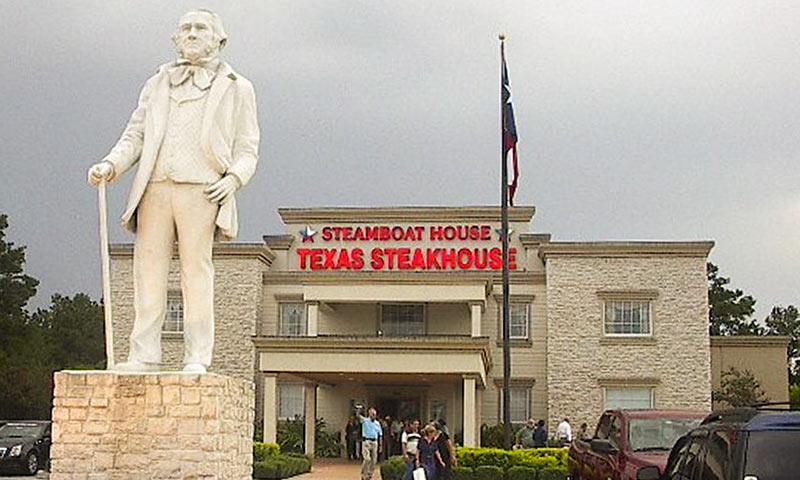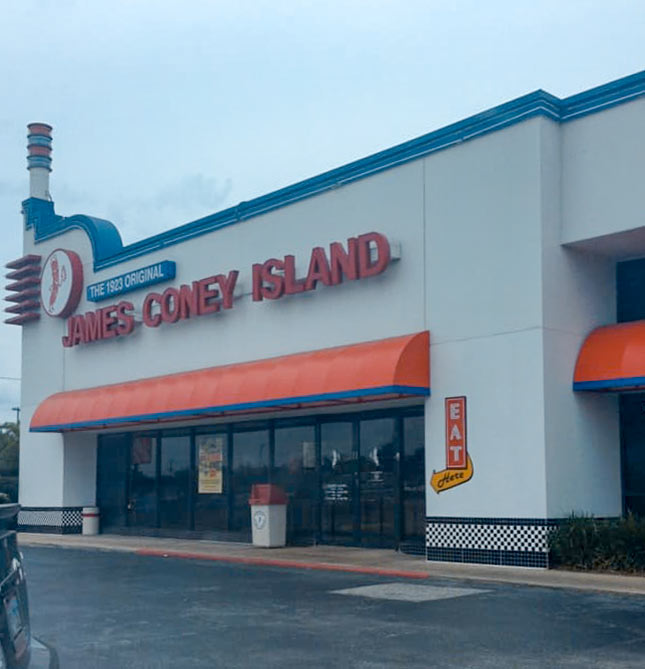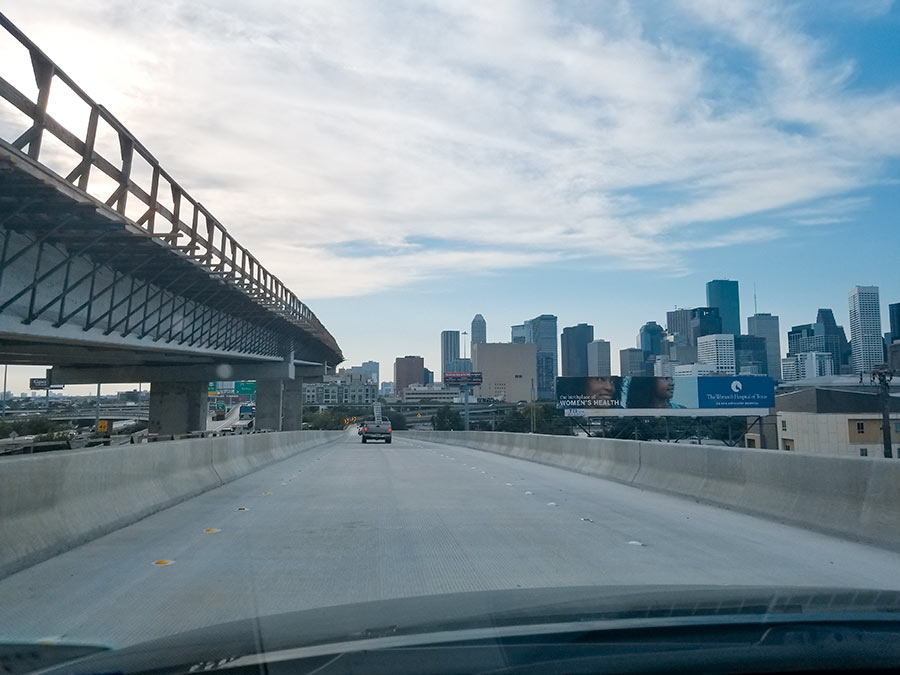DRIVING BELTWAY 8, IN ORDER TO READ HOUSTON IN THE ORIGINAL  “To get a full sense of the place,” writes Cort McMurray, every Houstonian should travel Beltway 8’s full 83-mile circuit. Until you can find the time, though, his tour narrative may have to suffice: “Keep going. You’re not even halfway around. There are more factories, and more office buildings, more new construction, more traffic. There’s a steak house, built to look like Sam Houston’s Huntsville home, evidence that if you give a Houstonian a little time and a little encouragement and the right financing, a Houstonian will create something ridiculous, and the horse track, where nothing ever appears to be happening. Near Bush Intercontinental, you’ll endure Roadwork Purgatory: orange cones and narrowed lanes and blinking signs, and no evidence of any work being done. It’s been that way for 19 years.
East of the airport, the Beltway crosses vast swaths of tract homes and the strip centers and megachurches that inevitably follow them, funneling you toward the Jesse Jones Bridge, standing like the skeleton of some humongous sauropod, head forever bent to the Ship Channel, nosing about for some seaweed.” [OffCite] Photo of Steamboat House Steakhouse: Tomball Sesquicentennial Promenaders
“To get a full sense of the place,” writes Cort McMurray, every Houstonian should travel Beltway 8’s full 83-mile circuit. Until you can find the time, though, his tour narrative may have to suffice: “Keep going. You’re not even halfway around. There are more factories, and more office buildings, more new construction, more traffic. There’s a steak house, built to look like Sam Houston’s Huntsville home, evidence that if you give a Houstonian a little time and a little encouragement and the right financing, a Houstonian will create something ridiculous, and the horse track, where nothing ever appears to be happening. Near Bush Intercontinental, you’ll endure Roadwork Purgatory: orange cones and narrowed lanes and blinking signs, and no evidence of any work being done. It’s been that way for 19 years.
East of the airport, the Beltway crosses vast swaths of tract homes and the strip centers and megachurches that inevitably follow them, funneling you toward the Jesse Jones Bridge, standing like the skeleton of some humongous sauropod, head forever bent to the Ship Channel, nosing about for some seaweed.” [OffCite] Photo of Steamboat House Steakhouse: Tomball Sesquicentennial Promenaders





Funny, I was just at the Steamboat House for lunch this afternoon. Lots of history in that place. I hear the owner even dresses up like Sam Houston.
I often drive the entire 610 Loop just to get a fresh perspective on the city, but Beltway 8? No, thanks; it’s not worth the cost of the tolls. The author effuses that driving the beltway “is realizing that every aggravation and aesthetic indignity eventually gives way to something amazing or outrageous, something inspiring or ridiculous, something you’ve never experienced before.” I’ve yet to see anything amazing or outrageous along the 8 corridor. In fact, it’s a depressing reminder of the unruly sprawl, cookie-cutter suburbs, generic strip malls and traffic congestion spawned by the Beltway’s very existence, which, rumor has it, was built because powerful politicians owned large tracts of land along the proposed route.
I get a well of anxiety and depression regarding the entire human race just at the thought of driving the beltway, don’t get me started on the nausea that I feel thinking about the ‘Grand’ parkway….
What is amazing is the miles of inadequate two-lane highway. A stunning lack of foresight for this town that we will regret during many years of reconstruction.
if I was the federal government I would be suing HCTRA like crazy for intentionally underfunding it’s connections and impeding the flow of every intrastate highway in the houston area. states should not be allowed the kind of power to purposely underfund infrastructure to the detriment of others. how many miles of the beltway used to be free and were taxpayer built before they were handed control of it anyhow?
@roadchick: “In fact, it’s a depressing reminder of the unruly sprawl, cookie-cutter suburbs, generic strip malls and traffic congestion spawned by the Beltway’s very existence, which, rumor has it, was built because powerful politicians owned large tracts of land along the proposed route.”
.
But that is, and always has been, Houston. That unruly sprawl, those cookie-cutter suburbs, generic strip malls, traffic congestion, that all existed long before the Beltway was built. I grew up here, in a cookie-cutter suburb called “Sagemont” located next to a 2 lane stretch of blacktop named “South Belt”. My dad grew up in a cookie-cutter suburb 10 miles closer in, filled with generic strip malls, just outside what would become the 610 loop. Today I live in another cookie-cutter suburb farther west, about half way between 610 and the Beltway. Still lots of congestion, sprawl, strip centers, etc. This is Houston, baby.
.
And just about everything in Houston exists because some powerful person (not necessarily a politician) owned tracts of land. All of those hip dense neighborhoods? They were empty fields that some speculator bought for next to nothing, then bribed … er, influenced someone in government to build something, often with tax dollars. That’s how things get done.
According to many Swamplot’ers, if it’s not Inside the Loop, it’s CRAP! Roadchick’s post captures it so wonderfully.
.
But not everyone can afford to live Inside the Loop, and not everyone wants to. There are affordable options ITL, but often these are small rentals: not suitable for a family. There are affordable options outside the Loop, and inside Beltway 8, but affordable neighborhoods in that area have faced such prejudice and neglect over the last 30 years, that many people don’t see them as an option. So many families really do see a move outside Beltway 8 as their only chance at an affordable, good sized house in a neighborhood that feels safe and has good schools.
.
At the same time, there’s a lot of money to be made in developing new roads on the outskirts of town. Opening up a road means skyrocketing land values around it. Ranchers get rich selling land to developers, who get rich selling houses to young families. Towns benefit from an increased tax base, and everybody’s happy. (Except Mother Earth).
.
This could change. But it would require major shifting of funds. Instead of subsidizing road construction, we would need to subsidize neighborhood improvements. And it would also require a major reconsidering of how we look at the City – from laissez-faire ‘run a crack house if you want to because it’s a bad neighborhood anyway’ to something more structured and with better rules and enforcement. Both of these proposals run headlong into opposition from people who benefit personally from the status quo.
About ten years ago, I drove the entire length of the Sam Houston Toll Road. It took awhile despite light traffic. I spent a few dollars on tolls but more on gas. The West side is fairly generic commercial developments while the East is generic industrial complexes. For a better perspective of Houston, drive the Loop. There’s a higher contrast of residential, commercial and industrial areas. On the westside, The Galleria and a plethora of luxury mid-rise office buildings. On the eastside, a dense industrial environments along the Ship Channel and a landfill to the east. And on the northside and the southside, a mix of odds and ends residential and commercial.
reeseman;
Harris Country had excellent foresight in building the Sam Houston Toll Road. It was planned during the 1960’s . Check out Erik Slotboom’s http://www.houstonfreeways.com website. (You can download a free copy of his excellent out-of-print book). Sure, it’s a toll road where I pay out over $100 a month using it. But, I rather have the added loop than none at all. Just visit Atlanta, only one loop, I-285.
joel;
I’ve been using the Westside portion since it opened in 1988. As long as I recall, it’s always been a toll road. Back then, tolls were 75 cents. The only free segment I know of is the short segment at the intersection of 59.
Getting back on topic, drive the 610 Loop to gain a better perspective of Houston.
Actually, driving the entirety of the Beltway is a good reminder of how quickly the “preferred” suburbs move ever-farther away from the urban core – nearly the entire stretch (apart from the Memorial corridor, Fall Creek, maybe the southeast corner of Pasadena, and maybe Jersey Village – maybe) consists of areas that college-educated homebuyers shun as if they are inner-city ghettos. And good portions of it, frankly, are exactly that.
“and the horse track, where nothing ever appears to be happening.”
Sarcasm, right? There’s a huge EDM festival in October, races all the time, concerts, shows, events, I mean did you do any research? Just a few weekends ago I went to check it out and saw Sarah Pepper and other local news casters/tv personalities racing on camels.
Half of the Beltway (northwest/southeast), go through almost exurban portions of land (undeveloped, and unlike most places in the metro).
The majority of the year there is nothing happening at the horse track. Simple fact.
Having just driven about 20 miles of it this morning, I’ll say it’s a great place to see tilt wall construction.
@Actually The tone in the post makes it read like nothing ever happens there (ever, which is used above). A majority of the year nothing happens at the Toyota Center, or actually any stadium/convention space… That doesn’t mean that they aren’t money generating, functioning, and lively venues.
*Edit* I meant to say southwest portions of the beltway, not southeast.
OMG and Northeast. I have my axis mixed up. Just ignore me.
Yes, I’ve lived inside the loop for 25 of my 35 years in Houston, but I’m not saying the suburbs are crap. In our rush to the exurbs, we’ve skipped over an entire ring of subdivisions between 610 and Beltway 8 with decent, although older, home stock that’s ripe for revitalization. The Beltway finally connected some pre-existing suburbs, but all new developments are pretty much indistinguishable from one another, and they’re mostly bedroom communities whose residents work elsewhere. To me, it’s a perfect example of the downside of sprawl. The further out we build, the worse traffic becomes; a vicious cycle we may never escape. They’re even talking about a fourth loop outside the Grand Parkway, for crissakes! When does it end?
So, Memebag, are you complaining because you have a home to live in? Would you prefer these no-name monsters of capitalism take their money and go elsewhere so you could live along Buffalo Bayou in a tent with the mosquitoes? I swear I don’t understand why everyone is always gritching about developers. If you don’t want a home and a Walmart, go live in some third world country and experience what life is like without someone willing to invest their money in making us all live better. I have lived in places like that and believe me, Houston is heaven compared to them. And while I’m at it, ask me how many people in those other places where I lived wanted to come to the United States and live? Everyone. one. Of. them.
Thank you. I feel much better getting that off my chest. And btw, if that’s not what you meant, imma sorry.
@Fannie: I’m the one defending sprawl and development. I miss the billboards of my youth. I love my cookie cutter neighborhood. I love generic strip malls, especially when they make it profitable for immigrants to sell me their native foods.
.
In other words, I love Houston as it really is. I don’t want to turn it into San Francisco or Paris. That would be a kind of meta-sprawl, reducing the real choices people get to make about the kind of place they want to live. Let’s embrace what makes Houston different.
Ok, good for you, @Memebag. After I ranted and raved, I suddenly wasn’t sure about how you felt. I do that frequently. Thank you for your love of Houston and excuse my confusion. Once I get going on a topic, it develops a life of its own.